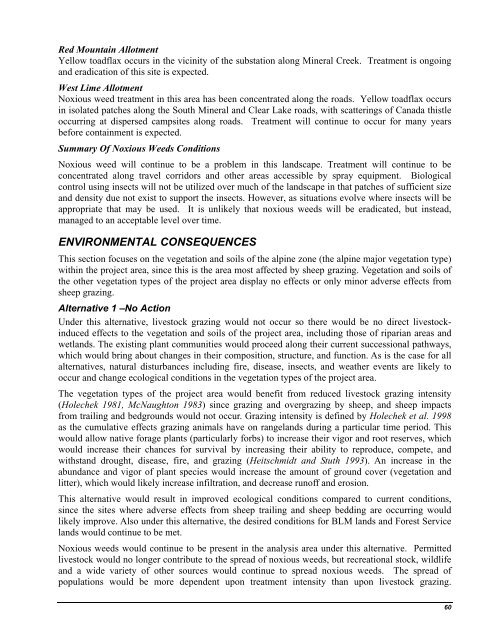NEPA--Environmental Assessment
NEPA--Environmental Assessment
NEPA--Environmental Assessment
You also want an ePaper? Increase the reach of your titles
YUMPU automatically turns print PDFs into web optimized ePapers that Google loves.
Red Mountain Allotment<br />
Yellow toadflax occurs in the vicinity of the substation along Mineral Creek. Treatment is ongoing<br />
and eradication of this site is expected.<br />
West Lime Allotment<br />
Noxious weed treatment in this area has been concentrated along the roads. Yellow toadflax occurs<br />
in isolated patches along the South Mineral and Clear Lake roads, with scatterings of Canada thistle<br />
occurring at dispersed campsites along roads. Treatment will continue to occur for many years<br />
before containment is expected.<br />
Summary Of Noxious Weeds Conditions<br />
Noxious weed will continue to be a problem in this landscape. Treatment will continue to be<br />
concentrated along travel corridors and other areas accessible by spray equipment. Biological<br />
control using insects will not be utilized over much of the landscape in that patches of sufficient size<br />
and density due not exist to support the insects. However, as situations evolve where insects will be<br />
appropriate that may be used. It is unlikely that noxious weeds will be eradicated, but instead,<br />
managed to an acceptable level over time.<br />
ENVIRONMENTAL CONSEQUENCES<br />
This section focuses on the vegetation and soils of the alpine zone (the alpine major vegetation type)<br />
within the project area, since this is the area most affected by sheep grazing. Vegetation and soils of<br />
the other vegetation types of the project area display no effects or only minor adverse effects from<br />
sheep grazing.<br />
Alternative 1 –No Action<br />
Under this alternative, livestock grazing would not occur so there would be no direct livestockinduced<br />
effects to the vegetation and soils of the project area, including those of riparian areas and<br />
wetlands. The existing plant communities would proceed along their current successional pathways,<br />
which would bring about changes in their composition, structure, and function. As is the case for all<br />
alternatives, natural disturbances including fire, disease, insects, and weather events are likely to<br />
occur and change ecological conditions in the vegetation types of the project area.<br />
The vegetation types of the project area would benefit from reduced livestock grazing intensity<br />
(Holechek 1981, McNaughton 1983) since grazing and overgrazing by sheep, and sheep impacts<br />
from trailing and bedgrounds would not occur. Grazing intensity is defined by Holechek et al. 1998<br />
as the cumulative effects grazing animals have on rangelands during a particular time period. This<br />
would allow native forage plants (particularly forbs) to increase their vigor and root reserves, which<br />
would increase their chances for survival by increasing their ability to reproduce, compete, and<br />
withstand drought, disease, fire, and grazing (Heitschmidt and Stuth 1993). An increase in the<br />
abundance and vigor of plant species would increase the amount of ground cover (vegetation and<br />
litter), which would likely increase infiltration, and decrease runoff and erosion.<br />
This alternative would result in improved ecological conditions compared to current conditions,<br />
since the sites where adverse effects from sheep trailing and sheep bedding are occurring would<br />
likely improve. Also under this alternative, the desired conditions for BLM lands and Forest Service<br />
lands would continue to be met.<br />
Noxious weeds would continue to be present in the analysis area under this alternative. Permitted<br />
livestock would no longer contribute to the spread of noxious weeds, but recreational stock, wildlife<br />
and a wide variety of other sources would continue to spread noxious weeds. The spread of<br />
populations would be more dependent upon treatment intensity than upon livestock grazing.<br />
60

















